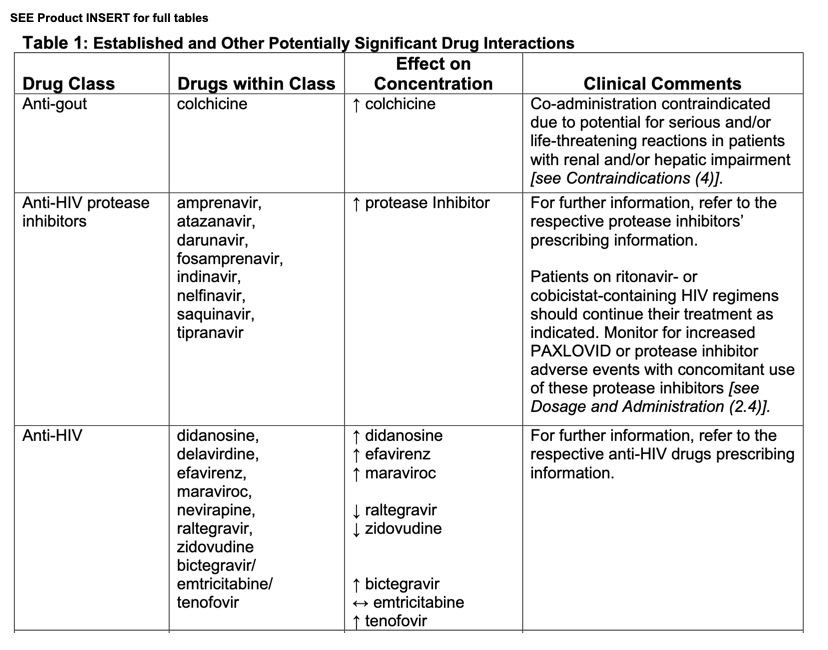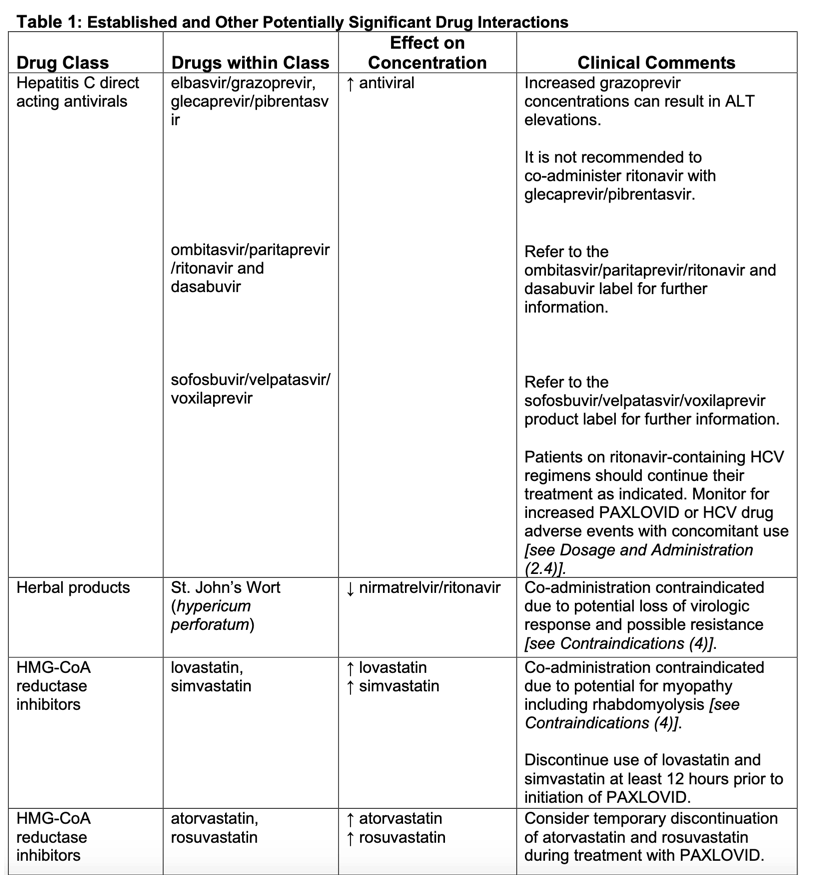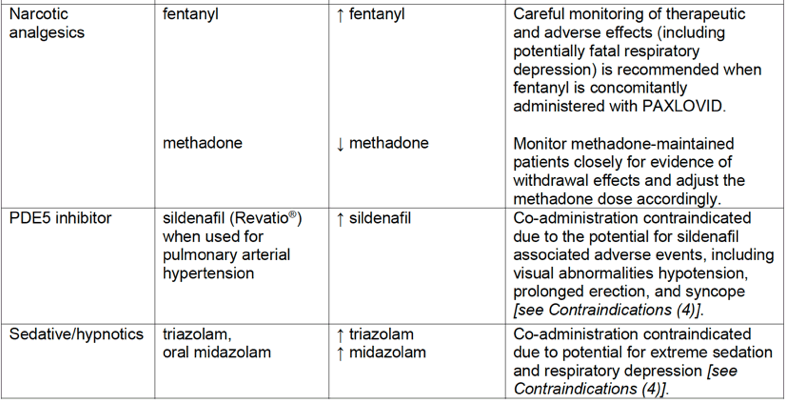| |
Pfizer COVID Protease & DDIs with HIV ARTs
|
| |
| |
FACT SHEET FOR HEALTHCARE PROVIDERS:
EMERGENCY USE AUTHORIZATION FOR PAXLOVIDTM
Download the PDF here
the PI says:
https://www.fda.gov/media/155050/download
"Patients on ritonavir- or cobicistat-containing HIV regimens should continue their treatment as indicated. Monitor for increased PAXLOVID or protease inhibitor adverse events with concomitant use of these protease inhibitors [see Dosage and Administration (2.4)].
2.4
Important Drug Interactions with PAXLOVID
No dosage adjustment is required when co-administered with other products containing ritonavir or
cobicistat.
Patients on ritonavir- or cobicistat-containing HIV or HCV regimens should continue their treatment as
indicated.
Refer to other sections of the Fact Sheet for important drug interactions with PAXLOVID. Consider
the potential for drug interactions prior to and during PAXLOVID therapy and review concomitant
medications during PAXLOVID therapy [see Contraindications (4), Warnings and Precautions (5.1),
and Drug Interactions (7)].
It is not recommended to co-administer ritonavir with glecaprevir/pibrentasvir.
Patients on ritonavir-containing HCV regimens should continue their treatment as indicated. Monitor for increased PAXLOVID or HCV drug adverse events with concomitant use [see Dosage and Administration (2.4)].
Discontinue use of lovastatin and simvastatin at least 12 hours prior to initiation of PAXLOVID.
Co-administration contraindicated due to the potential for sildenafil associated adverse events, including visual abnormalities hypotension, prolonged erection, and syncope [see Contraindications (4)]."



Animal Data
Nirmatrelvir
Embryo-fetal developmental (EFD) toxicity studies were conducted in pregnant rats and rabbits
administered oral nirmatrelvir doses of up to 1,000 mg/kg/day during organogenesis [on Gestation
Days (GD) 6 through 17 in rats and 6 through 19 in rabbits]. No biologically significant developmental
effects were observed in the rat EFD study. At the highest dose of 1,000 mg/kg/day, the systemic
nirmatrelvir exposure (AUC24) in rats was approximately 8 times higher than clinical exposures at the
authorized human dose of PAXLOVID. In the rabbit EFD study, lower fetal body weights (9%
decrease) were observed at 1,000 mg/kg/day in the absence of significant maternal toxicity findings.
At 1,000 mg/kg/day, the systemic exposure (AUC24) in rabbits was approximately 10 times higher
than clinical exposures at the authorized human dose of PAXLOVID. No other significant
developmental toxicities (malformations and embryo-fetal lethality) were observed at up to the highest
dose tested, 1,000 mg/kg/day. No developmental effects were observed in rabbits at 300 mg/kg/day
resulting in systemic exposure (AUC24) approximately 3 times higher than clinical exposures at the
authorized human dose of PAXLOVID. A pre- and postnatal developmental (PPND) study in pregnant
rats administered oral nirmatrelvir doses of up to 1,000 mg/kg/day from GD 6 through Lactation
Day (LD) 20 is ongoing and only interim data through postnatal day (PND) 56 are currently available.
Although no difference in body weight was noted at birth when comparing offspring born to nirmatrelvir treated versus control animals, a decrease (8% in males and females) in the body weight of offspring was observed at PND 17. No significant differences in offspring body weight were observed from PND 28 to PND 56. The maternal systemic exposure (AUC24) at 1,000 mg/kg/day was approximately 8 times higher than clinical exposures at the authorized human dose of PAXLOVID. No body weight changes in the offspring were noted at 300 mg/kg/day, resulting in systemic exposure (AUC24) approximately 5 times higher than clinical exposures at the authorized human dose of
PAXLOVID.
Ritonavir
Ritonavir was administered orally to pregnant rats (at 0, 15, 35, and 75 mg/kg/day) and rabbits (at 0,
25, 50, and 110 mg/kg/day) during organogenesis (on GD 6 through 17 and 6 through 19,
respectively). No evidence of teratogenicity due to ritonavir was observed in rats and rabbits at
systemic exposures (AUC) approximately 4 times higher than exposure at the authorized human dose of PAXLOVID. Increased incidences of early resorptions, ossification delays, and developmental variations, as well as decreased fetal body weights were observed in rats in the presence of maternal toxicity, at systemic exposures approximately 4 times higher than exposure at the authorized human dose of PAXLOVID. A slight increase in the incidence of cryptorchidism was also noted in rats (at a maternally toxic dose) at an exposure approximately 5 times the exposure at the authorized human dose of PAXLOVID. In rabbits, resorptions, decreased litter size, and decreased fetal weights were observed at maternally toxic doses approximately 11 times higher than the authorized human dose of PAXLOVID, based on a body surface area conversion factor. In a pre- and postnatal development study in rats, administration of 0, 15, 35, and 60 mg/kg/day ritonavir from GD 6 through postnatal day 20 resulted in no developmental toxicity, at ritonavir doses 3 times higher than the authorized human dose of PAXLOVID, based on a body surface area conversion factor.
|
|
| |
| |
|
|
|